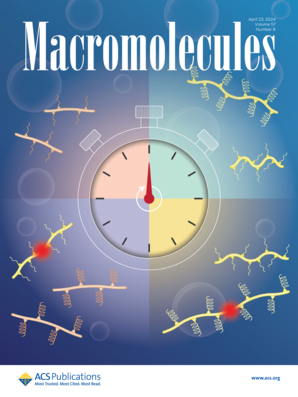Preparation of Polyethoxysiloxanes as a Solid (“a Solid Sol”) by Acid-Catalyzed Sol–Gel Reaction of Tetraethoxysilane
IF 5.1
1区 化学
Q1 POLYMER SCIENCE
引用次数: 0
Abstract
We successfully prepared polyethoxysiloxanes (PEOS) as solids with molecular weights ranging from 3700 to 12800, which have not been reported heretofore. PEOS was synthesized using three methods: (A) solvent removal under heating with a nitrogen flow, (B) refluxing, and (C) solvent evaporation by heating. In method B, PEOS was obtained as a solid regardless of molecular weight, which was comparable to the molecular weight in method A. Solid PEOS was soluble in organic solvents, insoluble in hexane, and exhibited stability against self-condensation, even with a high silica content of 57%–61%. It remained stable against self-condensation for over a year in a 40 wt % solution of tetrahydrofuran. The structure of PEOS was estimated to consist of either a local ladder or a cage structure, based on the relative ratio of the unit structures, Qn, and the results of spectral analysis. PEOS is regarded as a potential precursor for coatings because it produces coating films with a high pencil hardness of ≥4H.

四乙氧基硅烷酸催化溶胶-凝胶反应制备固体聚氧基硅氧烷(固体溶胶
我们成功地制备了分子量为3700 ~ 12800的聚氧硅氧烷(PEOS),这是目前尚未报道的。PEOS的合成采用三种方法:(A)在氮气流下加热脱溶剂,(B)回流,(C)加热蒸发溶剂。在方法B中,无论PEOS的分子量如何,都以固体形式得到,与方法a中的分子量相当。固体PEOS可溶于有机溶剂,不溶于己烷,即使在二氧化硅含量高达57%-61%的情况下,也表现出抗自缩合的稳定性。它在40%的四氢呋喃溶液中保持稳定,抗自缩合超过一年。根据单元结构的相对比Qn和光谱分析结果,PEOS的结构可能是局部阶梯结构或笼状结构。PEOS被认为是一种潜在的涂料前驱体,因为它生产的涂层具有≥4H的高铅笔硬度。
本文章由计算机程序翻译,如有差异,请以英文原文为准。
求助全文
约1分钟内获得全文
求助全文
来源期刊

Macromolecules
工程技术-高分子科学
CiteScore
9.30
自引率
16.40%
发文量
942
审稿时长
2 months
期刊介绍:
Macromolecules publishes original, fundamental, and impactful research on all aspects of polymer science. Topics of interest include synthesis (e.g., controlled polymerizations, polymerization catalysis, post polymerization modification, new monomer structures and polymer architectures, and polymerization mechanisms/kinetics analysis); phase behavior, thermodynamics, dynamic, and ordering/disordering phenomena (e.g., self-assembly, gelation, crystallization, solution/melt/solid-state characteristics); structure and properties (e.g., mechanical and rheological properties, surface/interfacial characteristics, electronic and transport properties); new state of the art characterization (e.g., spectroscopy, scattering, microscopy, rheology), simulation (e.g., Monte Carlo, molecular dynamics, multi-scale/coarse-grained modeling), and theoretical methods. Renewable/sustainable polymers, polymer networks, responsive polymers, electro-, magneto- and opto-active macromolecules, inorganic polymers, charge-transporting polymers (ion-containing, semiconducting, and conducting), nanostructured polymers, and polymer composites are also of interest. Typical papers published in Macromolecules showcase important and innovative concepts, experimental methods/observations, and theoretical/computational approaches that demonstrate a fundamental advance in the understanding of polymers.
 求助内容:
求助内容: 应助结果提醒方式:
应助结果提醒方式:


